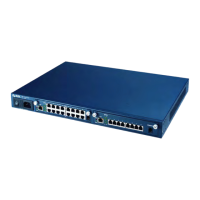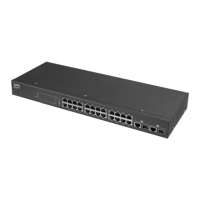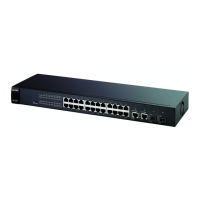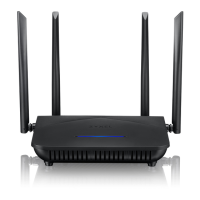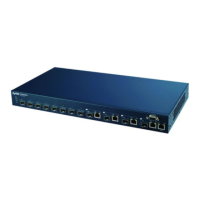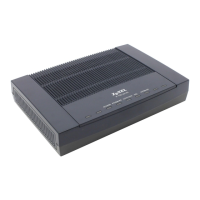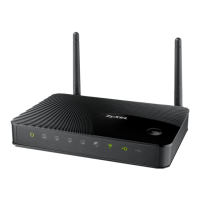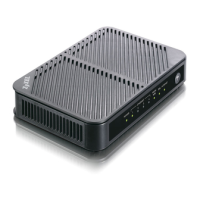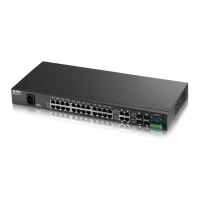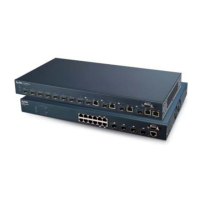Factory Default Settings Page: 32 IP Parameters Specifies the default IP address, subnet mask, and gateway for the IES-1000.
Console Port Defines the default settings for the console port, including baud rate, data bits, and flow control.
ADSL Ports (AAM1008) Outlines default encapsulation, multiplexing, VPI, VCI, operational mode, and rate settings for ADSL ports.
Ethernet Port Specifies default settings for the Ethernet port, including auto-negotiation, speed, and duplex mode.
Hardware Connections Page: 46 Front Panel Connections Illustrates front panel connections for SAM1008, including power, Ethernet switch, users, and management computer.
Console Port Explains using terminal emulator software to connect to a network module via the console port for initial configuration.
ADSL Port Connections Explains how AAM1008 module provides ADSL and voice services using telephone wiring and built-in splitters.
Typical Scenarios Describes typical installation scenarios for ADSL connections based on regional telephone wiring.
Installation Scenario A Details installing AAM1008 for data-access only in environments without prior MDFs or phone service.
Installation Scenario C Explains setup with two MDFs for end-user and CO connections, allowing for telephone-only or ADSL service.
Getting Started Screens Page: 75 General Setup Screen Details how to set up general identification information for the IES-1000, such as system name and location.
Bridge Overview Explains the IES-1000's IEEE 802.1D transparent bridging capabilities and MAC address learning.
Bridge Setup Screen Guides on accessing and understanding the Bridge Setup screen for configuring bridging and filtering features.
Port Filter Setup Screen Describes the screen for configuring port filtering rules, defining allowable outgoing ports for incoming traffic.
MAC Filter Setup Screen Details how to configure MAC filtering on ports to filter incoming frames based on specified MAC addresses.
IGMP Snooping Explains IGMP snooping to reduce multicast traffic by forwarding it only to member ports.
DHCP Relay Screen Guides on configuring DHCP relay settings, enabling relay, and specifying DHCP server addresses.
802.1 X Setup Screen Details how to enable IEEE 802.1X authentication on the IES-1000 and configure RADIUS server settings.
802.1 X Edit Screen Allows configuration of IEEE 802.1X security settings for individual ports, including control and re-authentication.
IP Setup Screen Guides on configuring the IES-1000's IP address, subnet mask, and default gateway for network management.
ADSL Module Port Setup Page: 99 Interleave Delay Explains interleave delay's role in error correction and its impact on data block size and performance.
Fast Mode Describes Fast Mode as a faster transmission option without interleaving, suitable for good lines.
Other Default Settings Lists other default settings for ADSL ports, including encapsulation, multiplexing, and operational mode.
ADSL Port Setup Displays port status, configuration, and assigned profiles, allowing access to individual port setup.
ADSL Profile Setup Screen Explains profiles as pre-configured DSL settings that can be assigned to ports for efficient configuration.
G.SHDSL Module Port Setup Page: 111 G.SHDSL Profiles Explains G.SHDSL profiles as pre-configured settings that can be assigned to ports for efficient configuration.
N-wire Mode Describes N-wire mode for bundling G.SHDSL ports into 4-wire or 8-wire connections to increase reach and bandwidth.
Port Bonding Explains how to combine G.SHDSL connections into a single logical connection to increase bandwidth for LAN-to-LAN applications.
G.SHDSL Port Setup Displays port status, configuration, and assigned profiles, allowing access to individual port setup.
G.SHDSL Add Profile Guides on creating G.SHDSL profiles with maximum and minimum speeds, and selecting PSD regions.
G.SHDSL Port Setup Allows configuration of G.SHDSL port settings like name, active state, priority, and profile.
Virtual Channel Management Page: 123 Set VCP Command Guides on creating or editing virtual channel profiles with parameters like encapsulation, ATM adaptation layer, and traffic class.
Delete VCP Command Explains how to delete a virtual channel profile, with restrictions on deleting the default profile or assigned profiles.
PVC Channels Explains defining channels (PVCs) to set priorities for services and subscribers using PVID and 802.1p priority.
Set Channel Command Guides on creating or modifying a PVC channel, specifying port, VPI, VCI, PVID, priority, and profile.
VLAN Page: 139 VLAN Overview Introduces VLANs as a way to partition a physical network into multiple logical networks for isolation and security.
Filtering Databases Describes filtering databases storing VLAN registration information for static and dynamic entries.
GARP Details Generic Attribute Registration Protocol for registering attribute values with GARP participants.
GVRP Explains GARP VLAN Registration Protocol for registering VLAN members on ports across the network.
VLAN Setup Guides on configuring VLAN settings for individual cards.
Static VLAN Setup Screen Describes the screen for setting up static VLANs, including enabling VLANs and managing VLAN IDs.
Maintenance Page: 151 Maintenance Overview Introduces the Maintenance screen for setting syslog parameters and accessing firmware/configuration management.
Maintenance Screen Describes the Maintenance screen for configuring UNIX syslog parameters and accessing links for secured client, firmware, and configuration management.
Secured Client Screen Details configuring trusted computers that can manage the IES-1000 via Telnet, FTP, and Web.
Firmware Upgrade Screen Guides on upgrading the network module's firmware via FTP or web configurator, emphasizing not interrupting the process.
Diagnostic Page: 163 Diagnostic Screen Describes the Diagnostic screen for checking system logs, resetting the system, and pinging IP addresses.
Log Format Explains the common format of system logs, including item number, time, process, type, and log message.
Log Messages Lists and describes various system log messages related to ADSL, G.SHDSL, and system events.
Reset System Explains how to restart the IES-1000 system, including a confirmation prompt.
Troubleshooting Page: 171 SHDSL or ADSL LED(s) Troubleshooting steps when SHDSL or ADSL LEDs are not on, checking port enablement and connections.
Data Transmission Troubleshooting steps when DSL LED is on but data cannot be transmitted, checking VPI/VCI, VLAN, and ping.
Data Rate Troubleshooting SYNC-rate discrepancies by connecting directly and checking phone wire quality.
Port Bonding Troubleshooting issues with bonded ports where the LED is off or the list ports command shows a dropped status.
Configured Settings Troubleshooting why configured settings do not take effect, emphasizing saving configurations.
Password Guidance on what to do if the network module password is forgotten, referring to firmware upgrade.
Local Server Troubleshooting issues where a computer cannot access a local server connected to the IES-1000.
SNMP Troubleshooting SNMP manager server issues, checking connectivity, configuration, and community settings.
Telnet Troubleshooting Telnet connection issues, checking existing sessions, secured hosts, and IP configuration.
Commands Page: 178 MAC Filter Commands Details commands for configuring MAC filtering, including enable, disable, add, and delete operations.
Buffer Commands Lists commands related to buffer management, including showing buffer pools and stealing buffers.
Chips Commands Details commands for monitoring CPU usage, debug mode, memory, stack, and reading/writing PHY registers.
Config Commands Lists commands for managing configuration, including listing, printing, saving, and resetting.
DHCP Relay Commands Lists commands for configuring DHCP relay, including add, delete, enable, disable, and status.
Ethernet Commands Details commands for configuring Ethernet port settings like auto-negotiation, duplex, and speed.
FSHS Commands Lists commands for managing the FLASHFS file system, including check, format, trace, and wipe operations.
ADSL Commands Lists commands for configuring ADSL ports and profiles, including enabling/disabling ports, setting rates, and managing PVCs.
G.SHDSL Commands Lists commands for configuring G.SHDSL ports and profiles, including enabling/disabling, setting rates, and managing bonding.
G.SHDSL Commands Details commands for G.SHDSL port bonding, N-wire groups, and deleting configurations.
G.SHDSL Commands Lists commands for monitoring G.SHDSL ports, including line information, performance counters, and port statistics.
IP Commands Details commands for configuring IP parameters, including ARP, subnet, route, and statistics.
SNMP Commands Details commands for SNMP access configuration, including adding, deleting, flushing, and listing entries.
Sys Commands Lists commands for system information, setting name, contact, location, mode, slot, and chassis.
VLAN Commands Details commands for configuring VLAN settings, including static, dynamic, and list commands.
System Commands Page: 194 Commonly Used Commands Lists and explains commonly used system commands such as uptime, version, restart, and passwd.
Passwd Command Explains the command to change the management password, emphasizing security and recovery.
Exit Command Explains the command to terminate the console or telnet management session.
Sys Commands Details system-related commands, including info, set name, set contact, set location, set mode, and set slot.
Secured Host Commands Allows up to ten remote administrators to access the IES-1000 via specified IP addresses.
UNIX Syslog Commands Explains using UNIX syslog commands to send logs to a server, detailing what is logged for DSL link status.
ADSL Commands Page: 200 ADSL Overview Refers to the web configurator chapter for background information on ADSL.
ADSL Commands Lists commands for configuring ADSL ports and profiles, including saving, enabling/disabling, and line data.
Disable Port Command Explains how to forcibly disable a specified ADSL port, noting factory defaults and heat generation.
Enable Port Command Explains how to forcibly enable a specified ADSL port, noting factory defaults and heat generation.
Linedata Command Shows the command to display ADSL port line bit allocation, indicating tone quality and interference.
Lineinfo Command Explains the command to display ADSL port line operating values, including modes, channels, and connection details.
Lineperf Command Displays ADSL port line performance counters, accumulating data since system start.
Line Performance Counters Defines various line performance counters for ADSL ports, including block errors, errored seconds, and unavailable seconds.
Linerate Command Explains the command to show line rate parameters of an ADSL port, including current and attainable rates.
Line Delay Command Details the command to set or display maximum interleave latency delay for ADSL ports.
List Port Command Shows the command to display configured rates, modes, and states of an individual ADSL port.
List Ports Command Displays configured maximum rates, modes, PSD region, and states of all ADSL ports.
Set Profile Command Guides on assigning a specific ADSL profile to a port and setting its operational mode.
List Profiles Command Displays all configured ADSL profiles and shows which profiles are assigned to each port.
Set Port Command Assigns a specific ADSL profile to an individual ADSL port and sets the port's operational mode.
Set Ports Command Applies a specific profile to all ADSL ports and sets their operational mode.
Show Port Command Shows the line status, actual rates, and mode of an individual ADSL port.
Set PVC Command Allows configuration of a PVC for an individual ADSL port, defining multiplexing mode and VPI/VCI.
Set PVCs Command Configures a single PVC for all ADSL ports simultaneously, defining multiplexing mode and VPI/VCI.
G.SHDSL Commands Page: 216 G.SHDSL Overview Refers to the web configurator chapter for background information on G.SHDSL.
G.SHDSL Commands Lists commands for configuring G.SHDSL ports and profiles, including saving, enabling/disabling, and line information.
Disable Port Command Explains how to forcibly disable a specified G.SHDSL port, noting factory defaults and heat generation.
Enable Port Command Explains how to forcibly enable a specified G.SHDSL port, noting factory defaults and heat generation.
Lineinfo Command Shows the command to display G.SHDSL port line operating values, including rate, errors, and noise margin.
Lineperf Command Displays G.SHDSL port line performance counters, accumulating data since system start.
List Port Command Displays information about G.SHDSL port line speed, state, and line rate parameters.
List Ports Command Shows configured minimum speeds, maximum speeds, mode, PSD region, and states of all G.SHDSL ports.
Set Profile Command Guides on setting a G.SHDSL profile for a port, defining speed and PSD region.
Set Port Command Assigns a specific G.SHDSL profile to an individual port and defines its maximum and minimum transmission rates.
Set PVC Command Allows configuration of a PVC for an individual G.SHDSL port, defining multiplexing mode and VPI/VCI.
Set PVCs Command Configures a single PVC for all G.SHDSL ports simultaneously, defining multiplexing mode and VPI/VCI.
Virtual Channel Management Page: 232 Set VCP Command Guides on creating or editing virtual channel profiles with parameters like encapsulation, ATM adaptation layer, and traffic class.
Delete VCP Command Explains how to delete a virtual channel profile, with restrictions on deleting the default profile or assigned profiles.
PVC Channels Explains defining channels (PVCs) to set priorities for services and subscribers using PVID and 802.1p priority.
Set Channel Command Guides on creating or modifying a PVC channel, specifying port, VPI, VCI, PVID, priority, and profile.
Bridge Commands Page: 244 Basic Commands Covers basic bridge commands like saving configuration, device information, and status.
MAC Filter Commands Details commands for filtering incoming frames based on MAC addresses, including enable, disable, add, and delete.
Mfilter Command Displays the multicast filtering database, monitoring IGMP snooping activities.
Flush Command Flushes out the filtering database of a specified bridge port or all ports.
Info Command Shows the software version number and maximum size of the filtering database.
Ethertype Command Controls which types of packets (any, IP, PPPoE) are forwarded to individual ports.
Portfilter Command Sets or displays the port-based VLAN configuration, defining allowed outgoing ports.
FPVID Command Allocates IEEE 802.1Q identification numbers (tags) on a port-by-port basis.
IEEE 802.1 Q Tagged VLAN Commands Page: 260 Configuring the Tagged VLAN Guides on configuring tagged VLANs, including assigning VLAN IDs, using fixed or normal administration control, and selecting tag control.
PVID Command Sets the VLAN ID to a specific port in the PVID table for untagged frames.
SVLAN CPU Command Registers the CPU as a port member of a static VLAN, allowing CPU static VLAN identification.
SVLAN List Command Displays the static VLAN registration table, showing VID, port number, administration control, and tag control.
SVLAN Setentry Command Adds or modifies entries in the static VLAN table, configuring VLAN ID, port number, administration, and tag control.
Forwarding Process Example Illustrates the frame forwarding decision process involving MAC filtering, PVID, SVLAN table, and port filter.
IP Commands Page: 272 Setting the IP Address Guides on setting the IP address, default gateway, and subnet mask of the Ethernet port.
General IP Commands Lists general IP commands for managing IP parameters, including config, version, and ping.
Config Command Shows the IP configuration and optionally saves it to nonvolatile memory.
Version Command Displays the IP version and MAC address of the network module.
Ping Command Checks network functionality by sending an echo request to another IP host.
Statistics Command Shows or resets statistics for traffic types like ARP, ICMP, IP, raw, TCP, and UDP.
Subnet Add Command Defines a subnet by specifying name, interface, IP address, and subnet mask.
Troubleshooting Page: 290 SHDSL or ADSL LED(s) Troubleshooting steps when SHDSL or ADSL LEDs are not on, checking port enablement and connections.
Data Transmission Troubleshooting steps when DSL LED is on but data cannot be transmitted, checking VPI/VCI, VLAN, and ping.
Data Rate Troubleshooting SYNC-rate discrepancies by connecting directly and checking phone wire quality.
Port Bonding Troubleshooting issues with bonded ports where the LED is off or the list ports command shows a dropped status.
Configured Settings Troubleshooting why configured settings do not take effect, emphasizing saving configurations.
Password Guidance on what to do if the network module password is forgotten, referring to firmware upgrade.
Local Server Troubleshooting issues where a computer cannot access a local server connected to the IES-1000.
SNMP Troubleshooting SNMP manager server issues, checking connectivity, configuration, and community settings.
Telnet Troubleshooting Telnet connection issues, checking existing sessions, secured hosts, and IP configuration.
